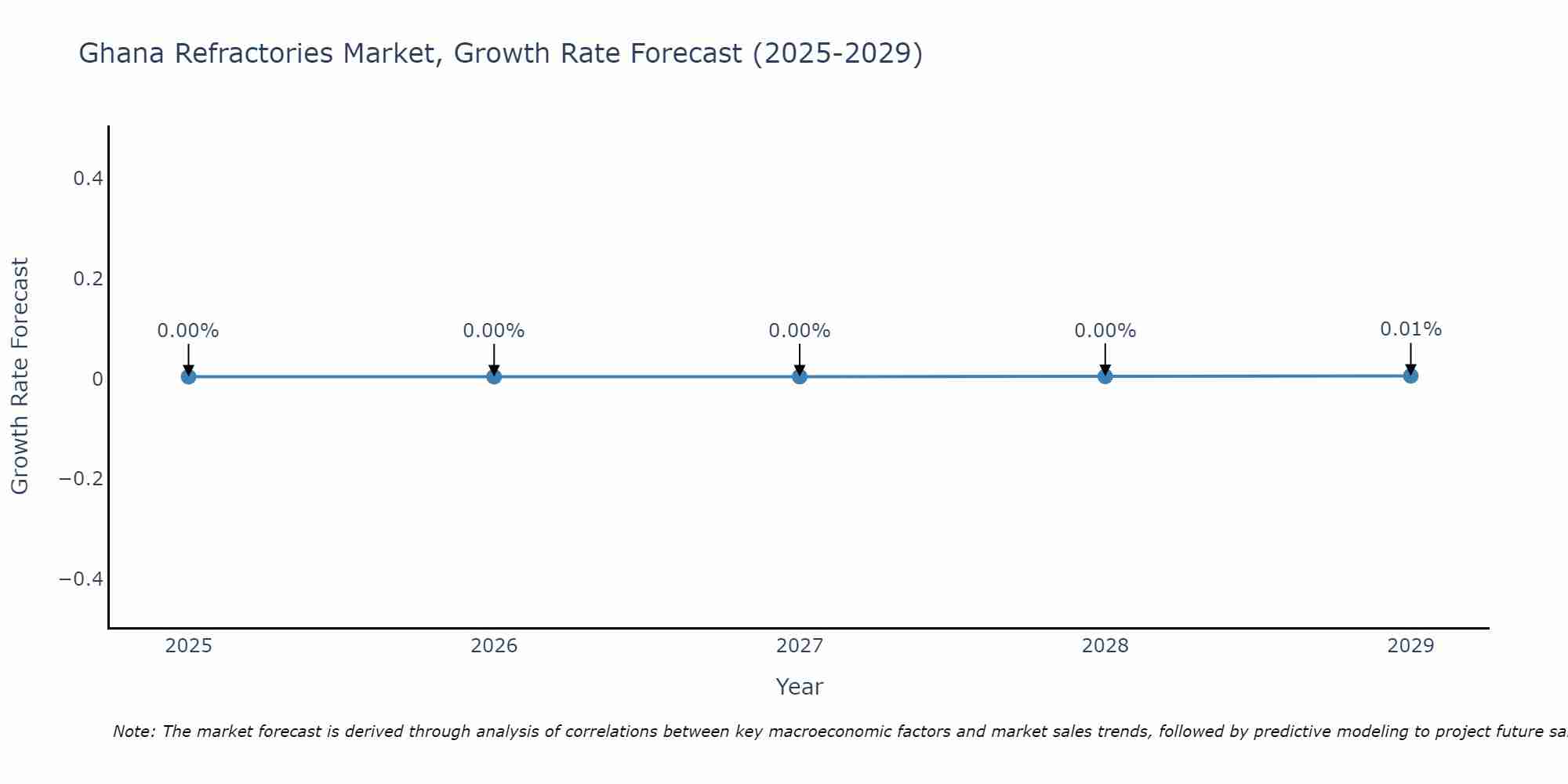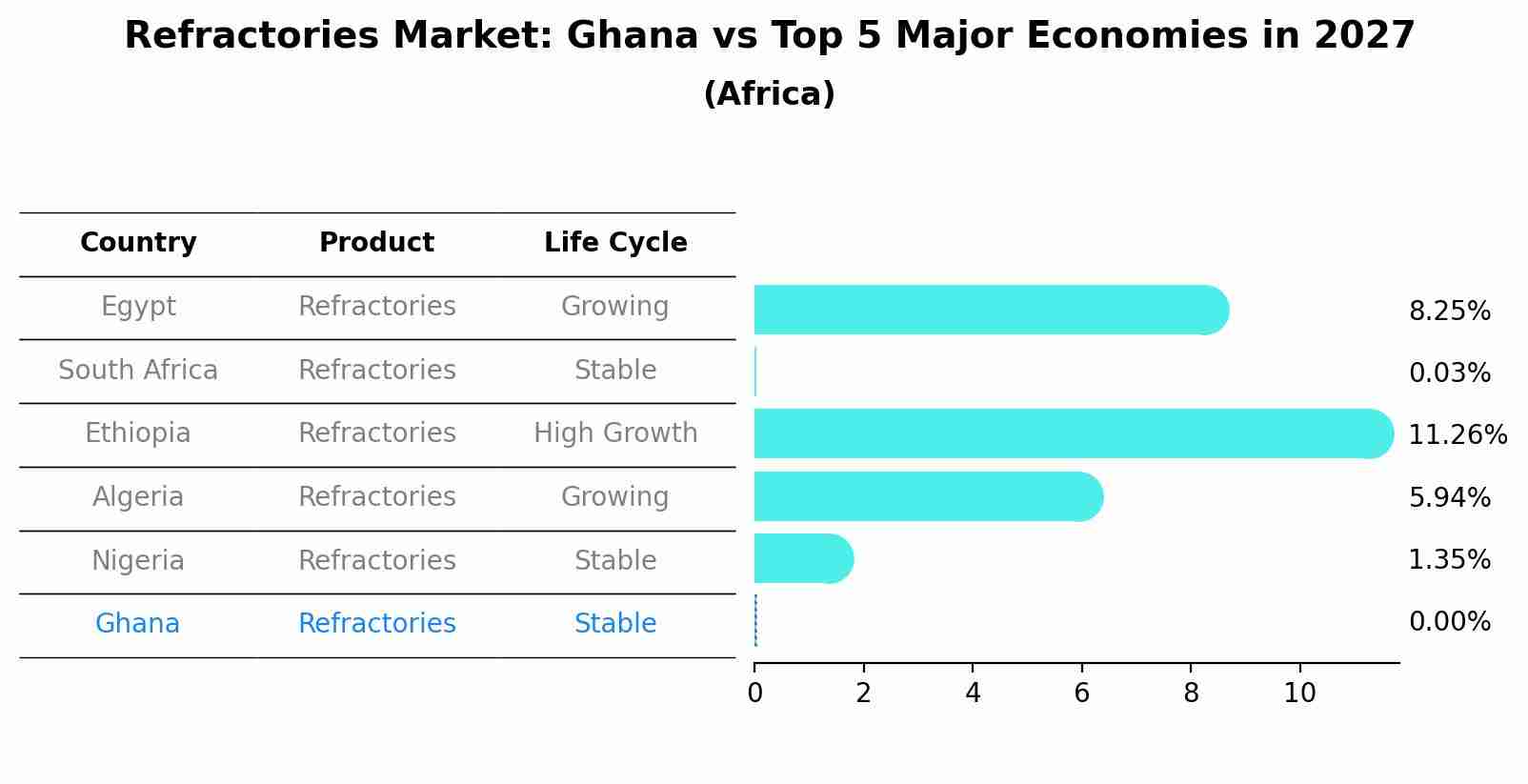Ghana Refractories Market (2025-2031) | Industry, Size, Growth, Outlook, Forecast, Share, Trends, Revenue, Analysis, Companies & Value
| Product Code: ETC008716 | Publication Date: Oct 2020 | Updated Date: Apr 2025 | Product Type: Report | |
| Publisher: 6Wresearch | Author: Ravi Bhandari | No. of Pages: 70 | No. of Figures: 35 | No. of Tables: 5 |
Ghana Refractories Market Size Growth Rate
The Ghana Refractories Market is poised for steady growth rate improvements from 2025 to 2029. Commencing at 0.00% in 2025, growth builds up to 0.01% by 2029.

Refractories Market: Ghana vs Top 5 Major Economies in 2027 (Africa)
The Refractories market in Ghana is projected to grow at a stable growth rate of 0.00% by 2027, within the Africa region led by Egypt, along with other countries like South Africa, Ethiopia, Algeria and Nigeria, collectively shaping a dynamic and evolving market environment driven by innovation and increasing adoption of emerging technologies.

Ghana Refractories Market Overview
The refractories market in Ghana provides heat-resistant materials such as bricks, castables, and monolithics used in high-temperature industrial processes such as steelmaking, cement production, and petrochemical refining.
Drivers of the market
The increasing demand from steel, cement, and glass industries, the growing investments in infrastructure and construction projects, and the adoption of refractory materials for high-temperature applications are driving the growth of Ghana refractories market. Refractories such as bricks, castables, and monolithics provide thermal insulation, chemical resistance, and mechanical strength in furnaces, kilns, and reactors, supporting industrial processes such as metal smelting, cement manufacturing, and glass production, thus fueling market growth.
Challenges of the market
The Ghana Refractories Market faces challenges related to raw material sourcing and availability. Refractory materials are essential for high-temperature industrial processes such as steelmaking, cement production, and glass manufacturing. However, the limited availability of certain raw materials, coupled with fluctuations in global commodity prices, can impact the cost and supply chain stability of refractories. Addressing this challenge requires diversification of raw material sources, investment in alternative materials research, and strategic partnerships with suppliers to ensure a reliable supply of refractory products.
Government Policy of the market
Recognizing the critical role of refractory materials in high-temperature industrial processes such as steelmaking, cement production, and glass manufacturing, the government of Ghana has implemented policies to regulate and support the refractories market. These policies aim to ensure the availability and quality of refractory products, promote technological innovation and adoption, and enhance local manufacturing capabilities. The government collaborates with regulatory agencies and industry associations to establish standards for refractory materials, installation techniques, and maintenance practices, and provides support for research and development initiatives to improve product performance and durability. Additionally, the government offers incentives such as tax breaks and grants to encourage investment in refractory production facilities and technology upgrades. By fostering a regulatory environment that prioritizes product quality, safety, and innovation, the government aims to support the growth of Ghana industrial sector, enhance competitiveness, and promote economic development and diversification.
Key Highlights of the Report:
- Ghana Refractories Market Outlook
- Market Size of Ghana Refractories Market, 2024
- Forecast of Ghana Refractories Market, 2031
- Historical Data and Forecast of Ghana Refractories Revenues & Volume for the Period 2021-2031
- Ghana Refractories Market Trend Evolution
- Ghana Refractories Market Drivers and Challenges
- Ghana Refractories Price Trends
- Ghana Refractories Porter's Five Forces
- Ghana Refractories Industry Life Cycle
- Historical Data and Forecast of Ghana Refractories Market Revenues & Volume By Form Types for the Period 2021-2031
- Historical Data and Forecast of Ghana Refractories Market Revenues & Volume By Shaped Refractories for the Period 2021-2031
- Historical Data and Forecast of Ghana Refractories Market Revenues & Volume By Unshaped Refractories for the Period 2021-2031
- Historical Data and Forecast of Ghana Refractories Market Revenues & Volume By Product Types for the Period 2021-2031
- Historical Data and Forecast of Ghana Refractories Market Revenues & Volume By Non-clay Refractory for the Period 2021-2031
- Historical Data and Forecast of Ghana Refractories Market Revenues & Volume By Clay Refractory for the Period 2021-2031
- Historical Data and Forecast of Ghana Refractories Market Revenues & Volume By End-users for the Period 2021-2031
- Historical Data and Forecast of Ghana Refractories Market Revenues & Volume By Iron & Steel for the Period 2021-2031
- Historical Data and Forecast of Ghana Refractories Market Revenues & Volume By Cement for the Period 2021-2031
- Historical Data and Forecast of Ghana Refractories Market Revenues & Volume By Non-Ferrous Metals for the Period 2021-2031
- Historical Data and Forecast of Ghana Refractories Market Revenues & Volume By Glass for the Period 2021-2031
- Historical Data and Forecast of Ghana Refractories Market Revenues & Volume By Others for the Period 2021-2031
- Ghana Refractories Import Export Trade Statistics
- Market Opportunity Assessment By Form Types
- Market Opportunity Assessment By Product Types
- Market Opportunity Assessment By End-users
- Ghana Refractories Top Companies Market Share
- Ghana Refractories Competitive Benchmarking By Technical and Operational Parameters
- Ghana Refractories Company Profiles
- Ghana Refractories Key Strategic Recommendations
Frequently Asked Questions About the Market Study (FAQs):
1 Executive Summary |
2 Introduction |
2.1 Key Highlights of the Report |
2.2 Report Description |
2.3 Market Scope & Segmentation |
2.4 Research Methodology |
2.5 Assumptions |
3 Ghana Refractories Market Overview |
3.1 Ghana Country Macro Economic Indicators |
3.2 Ghana Refractories Market Revenues & Volume, 2021 & 2031F |
3.3 Ghana Refractories Market - Industry Life Cycle |
3.4 Ghana Refractories Market - Porter's Five Forces |
3.5 Ghana Refractories Market Revenues & Volume Share, By Form Types, 2021 & 2031F |
3.6 Ghana Refractories Market Revenues & Volume Share, By Product Types, 2021 & 2031F |
3.7 Ghana Refractories Market Revenues & Volume Share, By End-users, 2021 & 2031F |
4 Ghana Refractories Market Dynamics |
4.1 Impact Analysis |
4.2 Market Drivers |
4.3 Market Restraints |
5 Ghana Refractories Market Trends |
6 Ghana Refractories Market, By Types |
6.1 Ghana Refractories Market, By Form Types |
6.1.1 Overview and Analysis |
6.1.2 Ghana Refractories Market Revenues & Volume, By Form Types, 2021-2031F |
6.1.3 Ghana Refractories Market Revenues & Volume, By Shaped Refractories, 2021-2031F |
6.1.4 Ghana Refractories Market Revenues & Volume, By Unshaped Refractories, 2021-2031F |
6.2 Ghana Refractories Market, By Product Types |
6.2.1 Overview and Analysis |
6.2.2 Ghana Refractories Market Revenues & Volume, By Non-clay Refractory, 2021-2031F |
6.2.3 Ghana Refractories Market Revenues & Volume, By Clay Refractory, 2021-2031F |
6.3 Ghana Refractories Market, By End-users |
6.3.1 Overview and Analysis |
6.3.2 Ghana Refractories Market Revenues & Volume, By Iron & Steel, 2021-2031F |
6.3.3 Ghana Refractories Market Revenues & Volume, By Cement, 2021-2031F |
6.3.4 Ghana Refractories Market Revenues & Volume, By Non-Ferrous Metals, 2021-2031F |
6.3.5 Ghana Refractories Market Revenues & Volume, By Glass, 2021-2031F |
6.3.6 Ghana Refractories Market Revenues & Volume, By Others, 2021-2031F |
7 Ghana Refractories Market Import-Export Trade Statistics |
7.1 Ghana Refractories Market Export to Major Countries |
7.2 Ghana Refractories Market Imports from Major Countries |
8 Ghana Refractories Market Key Performance Indicators |
9 Ghana Refractories Market - Opportunity Assessment |
9.1 Ghana Refractories Market Opportunity Assessment, By Form Types, 2021 & 2031F |
9.2 Ghana Refractories Market Opportunity Assessment, By Product Types, 2021 & 2031F |
9.3 Ghana Refractories Market Opportunity Assessment, By End-users, 2021 & 2031F |
10 Ghana Refractories Market - Competitive Landscape |
10.1 Ghana Refractories Market Revenue Share, By Companies, 2024 |
10.2 Ghana Refractories Market Competitive Benchmarking, By Operating and Technical Parameters |
11 Company Profiles |
12 Recommendations |
13 Disclaimer |
- Single User License$ 1,995
- Department License$ 2,400
- Site License$ 3,120
- Global License$ 3,795
Search
Related Reports
- Portugal Occupational Health & Safety Services Market (2025-2031) | Strategy, Consumer Insights, Analysis, Investment Trends, Opportunities, Growth, Size, Share, Industry, Revenue, Segments, Value, Segmentation, Supply, Forecast, Restraints, Outlook, Competition, Drivers, Trends, Demand, Pricing Analysis, Competitive, Strategic Insights, Companies, Challenges
- Netherlands Occupational Health and Safety Services Market (2025-2031) | Strategy, Consumer Insights, Analysis, Investment Trends, Opportunities, Growth, Size, Share, Industry, Revenue, Segments, Value, Segmentation, Supply, Forecast, Restraints, Outlook, Competition, Drivers, Trends, Demand, Pricing Analysis, Competitive, Strategic Insights, Companies, Challenges
- Belgium and Luxembourg Facility Management Market (2025-2031) | Strategy, Consumer Insights, Analysis, Investment Trends, Opportunities, Growth, Size, Share, Industry, Revenue, Segments, Value, Segmentation, Supply, Forecast, Restraints, Outlook, Competition, Drivers, Trends, Demand, Pricing Analysis, Competitive, Strategic Insights, Companies, Challenges
- Russia Women Intimate Apparel Market (2025-2031) | Strategy, Consumer Insights, Analysis, Investment Trends, Opportunities, Growth, Size, Share, Industry, Revenue, Segments, Value, Segmentation, Supply, Forecast, Restraints, Outlook, Competition, Drivers, Trends, Demand, Pricing Analysis, Competitive, Strategic Insights, Companies, Challenges
- Africa Chocolate Market (2025-2031) | Size, Share, Trends, Growth, Revenue, Analysis, Forecast, industry & Outlook
- Global Hydroxychloroquine And Chloroquine Market (2025-2031) | Industry, Trends, Size, Outlook, Growth, Value, Companies, Revenue, Analysis, Share, Forecast
- Saudi Arabia Plant Maintenance Market (2025-2031) | Industry, Size, Growth, Revenue, Value, Companies, Forecast, Analysis, Share & Trends
- Taiwan Electric Truck Market (2025-2031) | Outlook, Industry, Revenue, Size, Forecast, Growth, Analysis, Share, Companies, Value & Trends
- South Korea Electric Bus Market (2025-2031) | Outlook, Industry, Companies, Analysis, Size, Revenue, Value, Forecast, Trends, Growth & Share
- Africa Low Temperature Powder Coating Market (2025-2031) | Companies, Competition, Size, Challenges, Segmentation, Trends, Competitive, Industry, Supply, Strategy, Investment Trends, Growth, Segments, Restraints, Strategic Insights, Revenue, Share, Forecast, Drivers, Analysis, Pricing Analysis, Demand, Consumer Insights, Value, Opportunities, Outlook
Industry Events and Analyst Meet
Our Clients
Whitepaper
- Middle East & Africa Commercial Security Market Click here to view more.
- Middle East & Africa Fire Safety Systems & Equipment Market Click here to view more.
- GCC Drone Market Click here to view more.
- Middle East Lighting Fixture Market Click here to view more.
- GCC Physical & Perimeter Security Market Click here to view more.
6WResearch In News
- Doha a strategic location for EV manufacturing hub: IPA Qatar
- Demand for luxury TVs surging in the GCC, says Samsung
- Empowering Growth: The Thriving Journey of Bangladesh’s Cable Industry
- Demand for luxury TVs surging in the GCC, says Samsung
- Video call with a traditional healer? Once unthinkable, it’s now common in South Africa
- Intelligent Buildings To Smooth GCC’s Path To Net Zero













